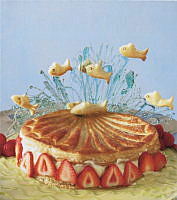From White House to Your House
A Brief Postcard History of 1600 Pennsylvania Avenue
Copyright © White House Historical Association. All rights reserved under international copyright conventions. No part of this article may be reproduced or utilized in any form or by any means, electronic or mechanical, including photocopying, recording, or by any information storage and retrieval system, without permission in writing from the publisher. Requests for reprint permissions should be addressed to books@whha.org
Chicagos 1893 Worlds Columbian Exposition gave us many firsts, among them the Ferris wheel, Pabst Blue Ribbon beer, and the introduction by the U.S. Post Office Department of the picture post card. Printed on government-issued postal cards with an imprinted one-cent stamp were illustrations of the fairs structures. Privately printed souvenir cards were also sold that depicted the fairs attractions, but these cards required two cents postage. Writing was not permitted on the address side of either card.
Soon after, private publishers began selling souvenir cards illustrating attractions in major U.S. cities, and Washington, D.C. was a perfect venue. A combined cost of three cents (equivalent to 77 cents today) bought a tourist a 3 x 5 illustrated piece of cardboard with a small space for a message that could be mailed. Delivery of the cards was swift, with transit between major cities taking a couple of days. If mailed to an address within a city, a card mailed in the morning was delivered that afternoon. A new, inexpensive means of rapid communications was born.
At the same time the White House was being increasingly regarded as a prime historic site for visitors to Washington who wanted to drop a line by postcard to family and friends back home. Between 10:00 a.m. and 3:00 p.m. on most days, visitors could enter through the North Door to walk through the entrance hall and visit the East Room, and tourists with an introductory card from their representative or senator could also secure admittance to some of the state rooms. Although no official tours were offered, White House doormen were often available to guide sightseers through the rooms and relate stories about presidents and first ladies.

Pioneer Era (pre 1898) Patriographic view published in 1897 by the American Souvenir Card Co.
This Patriographic card was published in 1897 by the American Souvenir Card Co. and is among the earliest cards printed that depict Washingtons government buildings. The White House soon became the most popular subject. Shown here is the White House, sharing space with statues honoring Rear Admiral Samuel F. Du Pont and General Winfield Scott Hancock. Behind the Hancock statue is the National Bank of Washington and the Apex Building facing 7th Street, N.W.
That white space at the lower right was all the sender had to document their travel adventures. This card falls into the category of what deltiologists (collectors who study postcards; from the Greek word deletion meaning writing tablet) called the Pioneer Era (1893-1898).
Continued confusion in the publics mind over the disparity between one-cent postage for government-issued cards and two-cents for privately printed cards necessitated an act of Congress on May 19, 1898. This act granted private publishers the right to print and sell cards that bore the inscription Private Mailing Card. These cards could be mailed for one cent, but messages still had to be confined to the image side. Called PMCs by collectors, these cards fall into the Private Mailing Card Era (1898-1901). This finely rendered view of the McKinley White House North Portico was published by Mrs. Howard Gray Douglas of Washington, D.C. and printed by the Photo Electric Engraving Co. of New York.

Private Mailing Card (1898-1901) Published by Mrs. Howard Gray Douglas, Washington, D.C., printed by the Photo Electric Engraving Co., New York.
Fast forward three and a half years to December 4, 1901, when the government granted the right to private printers to use the term Post Card. This marked the introduction of the Post Card Era (1901-1907), yet writing was still not permitted on the address side. This Sol Art Prints post card was published by the Rotograph Co. of New York City and printed in Germany, whose printers were far ahead those in the U.S. when it came to the lithographic process of printing. Titled Presidents Private Telephone & Telegraph Bureau, White House, plenty of space is set aside the image for a message.

Post Card Era (1901-1907) Sol Art Prints published by the Rotograph Co., New York.
Finally, on March 1, 1907, the post card floodgates burst wide open with the Divided Back Era (1907-1914). From that date on, senders of post cards could pen their messages on the address side, conveniently separated by a vertical line. In 1913 more than one billion post cards were delivered by the Post Office ten times the population of the U.S.

Divided Back Era (1907-1914) Published by Ezra Meeker.
This amazing post card depicts American pioneer Ezra Meekers (1830-1928) visit to the White House on November 29, 1907. Meeker had traveled the Oregon Trail by ox-drawn wagon as a young man. Convinced that the Trails history would be forgotten, Meeker retraced its route initially from 1906-1908 as part of his effort to construct monuments marking the trail.
From 1930-1944 the Linen Era evolved, with new printing processes that allowed post cards to be printed on high rag content paper that featured a linen-like texture. This 1933 moonlit view of the North Portico is an example the Art Colortone by the linen eras most prolific printer, Curteich of Chicago. The post card was sent by a Washington, D.C. member of Esters View Card Club in 1943 to a collector in Lynn, Massachusetts.

Linen Era (1930-1944) Art Colortone printed by Curteich, Chicago and published by B. S. Reynolds, Washington, DC.
The items displayed here are but a small sample of hundreds of Washington, D.C. post cards housed in the D.C. Public Librarys Washingtoniana Division, 901 G Street, N.W., Washington, D.C. A finding aid is available at http://www.h-net.org/~dclist/P30Postcards.pdf.








